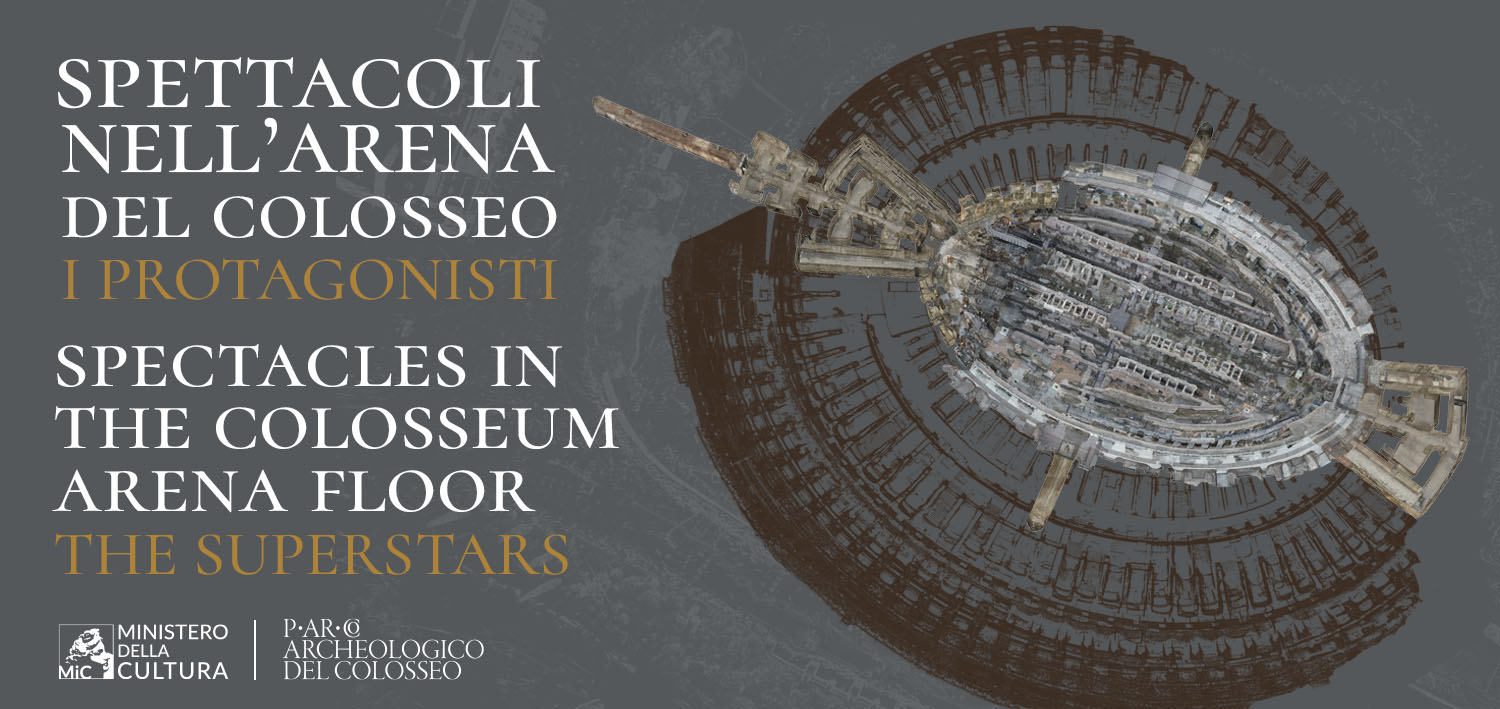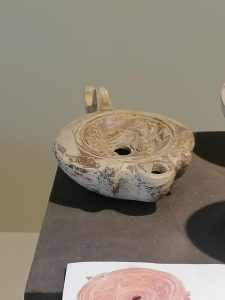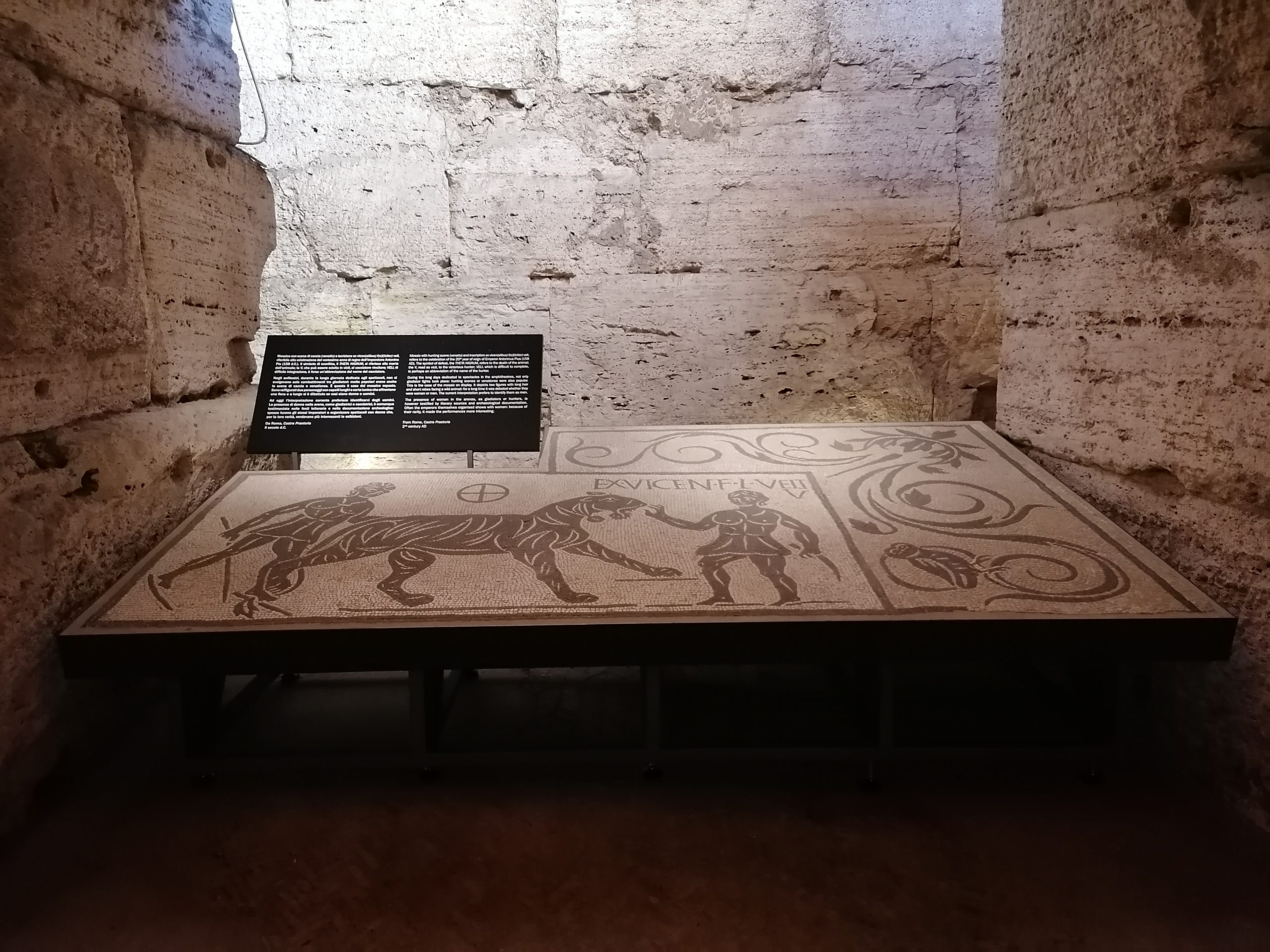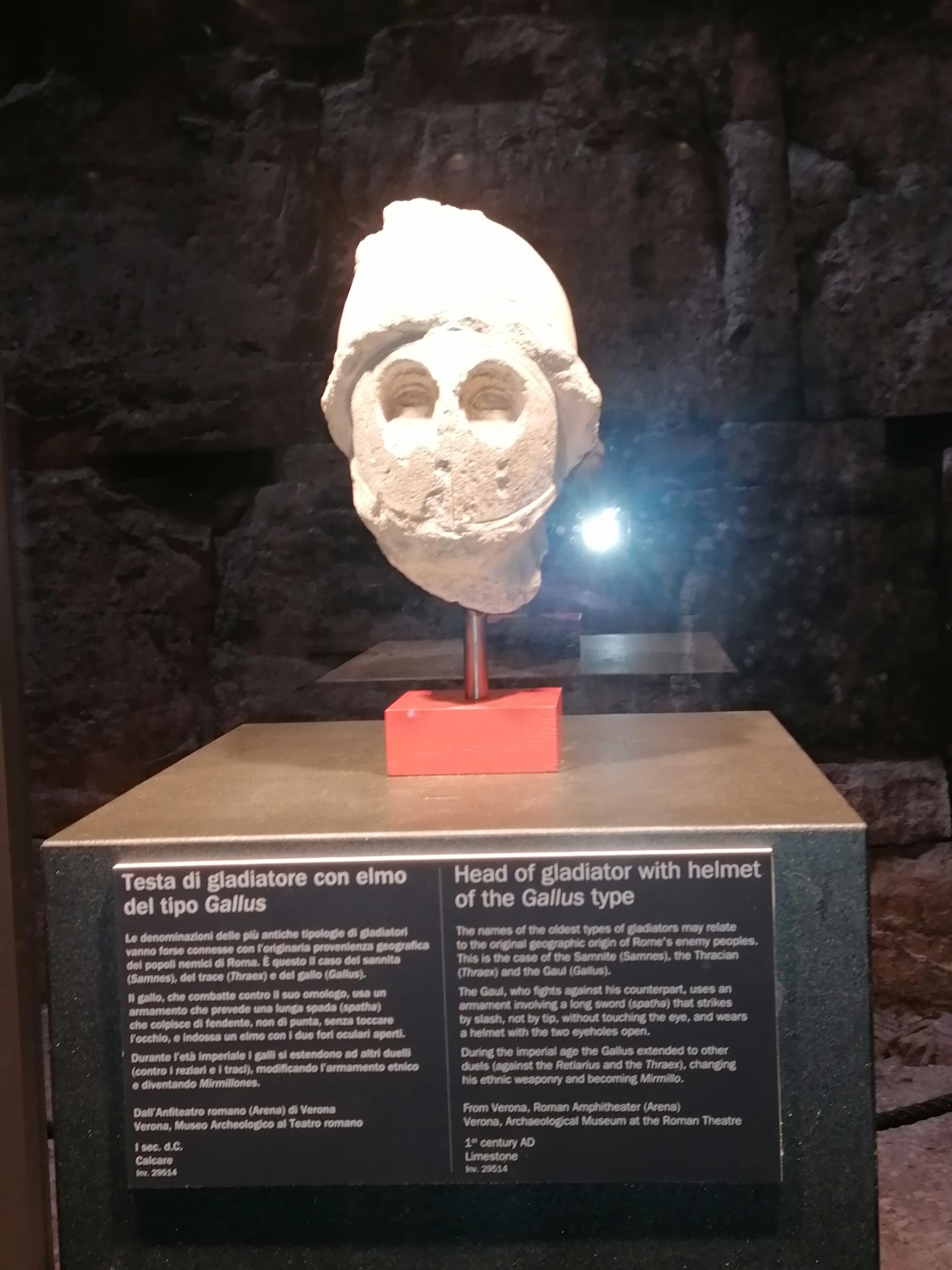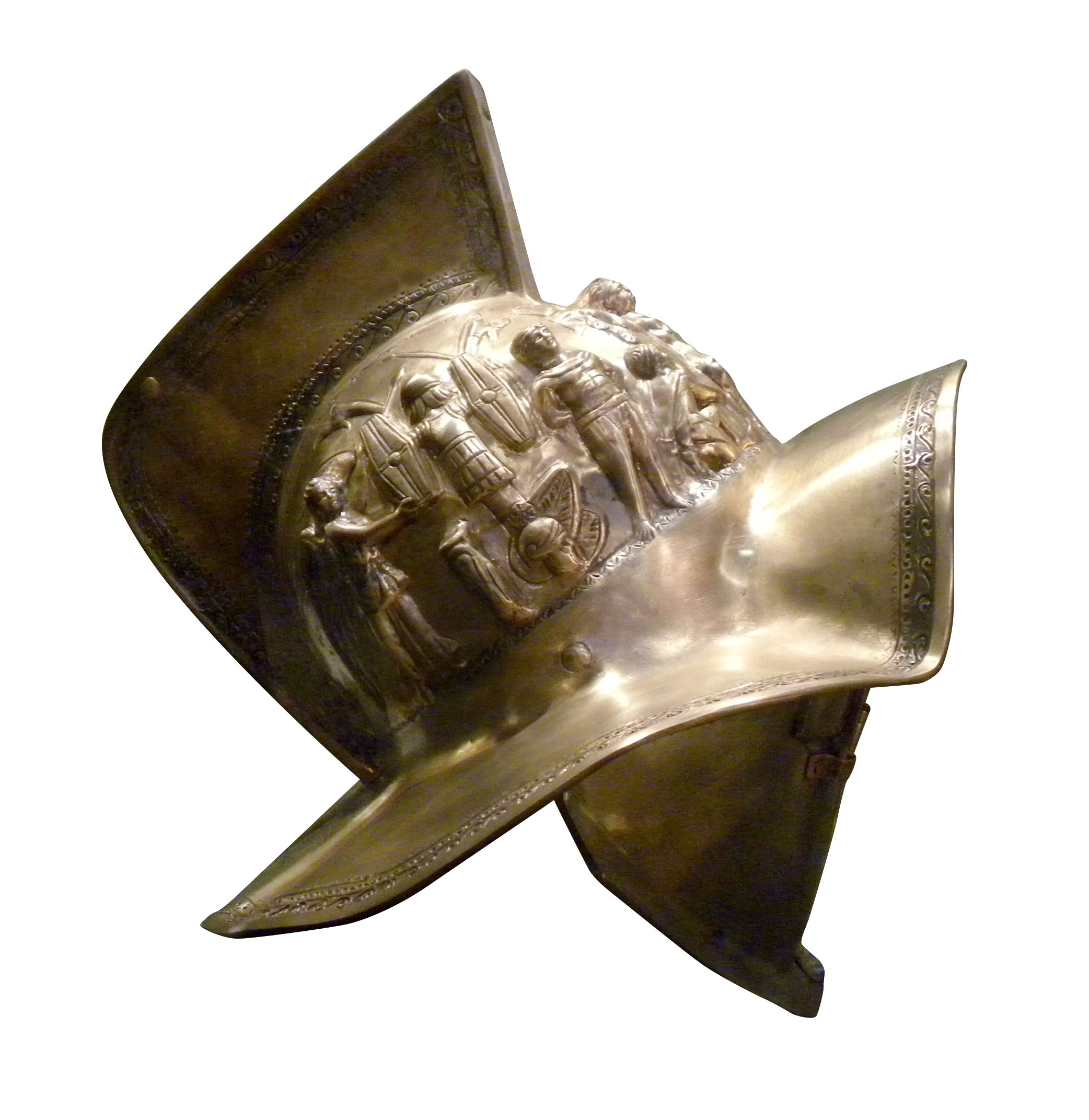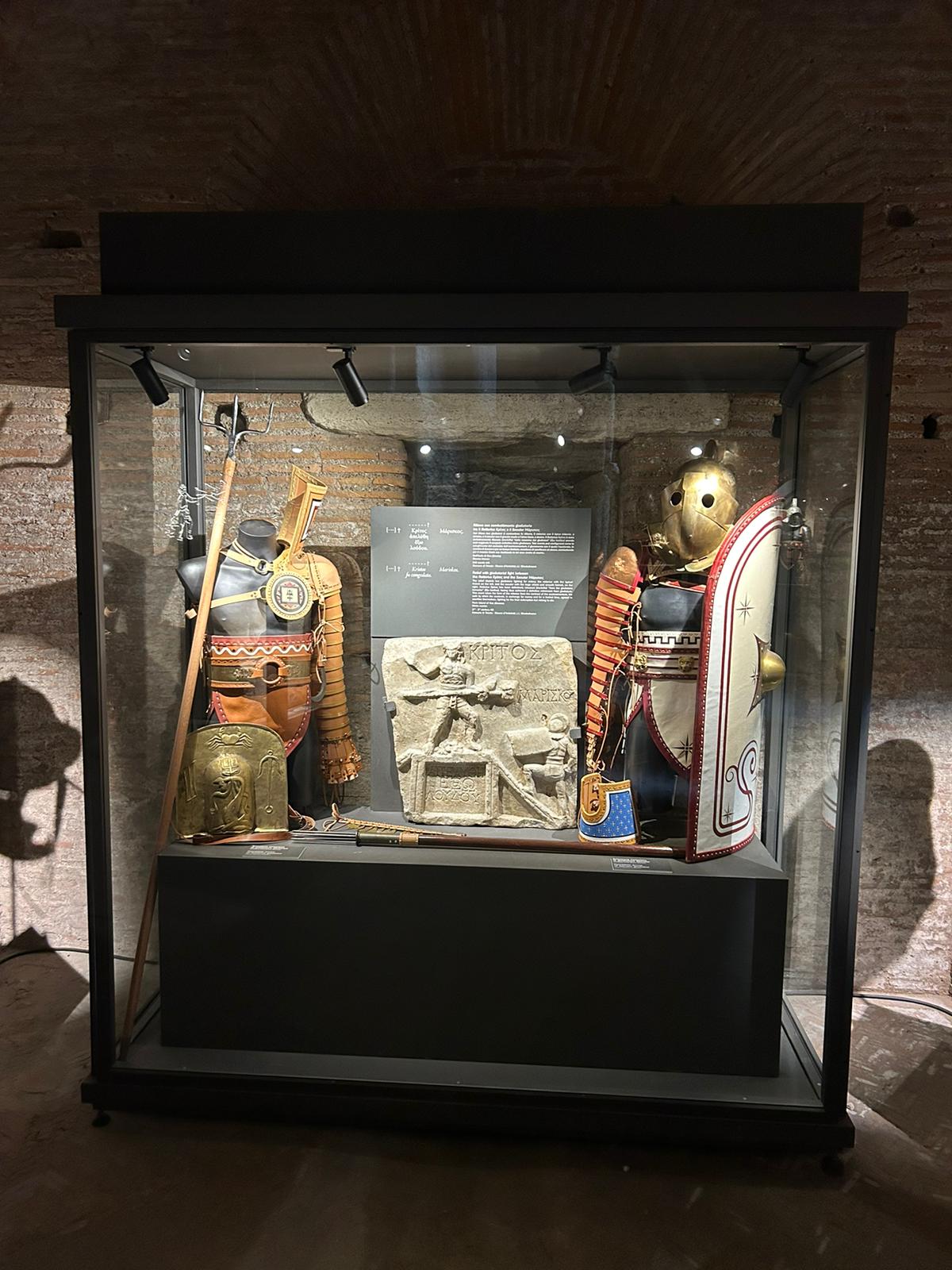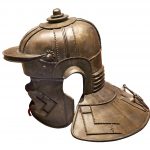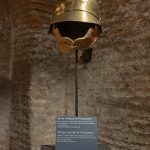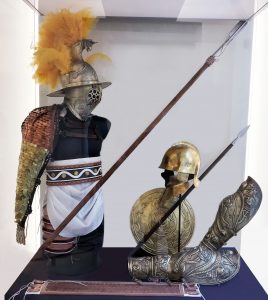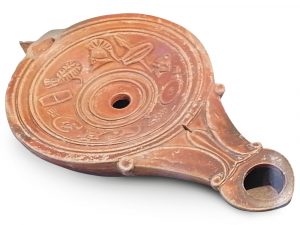Spectacles in the Colosseum Arena. The Superstars
Details
- Colosseum and Ludus Magnus: a revived connection
- The Origins of Gladiators
- The Gladiators' Couples
- Ambiente 2 - Mosaico con scena di caccia (venatio)
- Ambiente 3 - Head of gladiator with helmet of the Gallus type
- Room 4 - Murmillo and Thraex
- Room 5 - Secutor, Retiarius e Provocator
- Room 7 - The Hoplomachus or Thraex Type A
- Room 8 - Lifts and hoists for men and animals
- The Gladiators' Glossary
- Bibliography
Share
Why an exhibition in the underground levels of the Colosseum, already a ‘museum within a museum’?
The answer lies in the cultural strategy characterizing the actions of the Parco archeologico del Colosseo: the aim is – starting from the contexts of origin of the finds – to widen the cultural offer, also with innovative exhibitions, which render the function and the historical events of the monuments immediately perceptible, to involve the public in a more informed visit.
It is not unusual for such opportunities to happen within the framework of public-private partnerships: concerning these collaborations, the Parco archeologico has constantly developed a policy of participation with pivotal projects aimed, above all, at broadening both physical and cultural fruition and accessibility.
The exhibition-event ‘Gladiators in the Arena. Between Colosseum and Ludus Magnus‘ falled within this programmatic framework: the occasion was the restoration of the underground corridor, which once connected the Colosseum to the Ludus Magnus. That ancient connection, which had been interrupted since the 19th century by constructing a hydraulic sewer, was revived thanks to modern technologies.
In view of the great success of that first exhibition, the Parco archeologico del Colosseo is proposing for the period June 2024 – January 2025 a new exhibition, which aims to remain permanent even if in the rotation of exhibits, entitled Spectacles in the Colosseum Arena floor. The superstars.
The exhibition you are going to visit occupies the eastern sector of the underground level, the true backstage of the spectacles that took place on the arena floor. This area was, in ancient times, directly connected by a cryptoporticus (covered gallery) to the barracks for gladiators, the Ludus Magnus (‘large barrack’). The Ludus Magnus was in turn part of a larger quarter composed of other barracks and annexed facilities. Inside the gallery a multimedia installation will make you relive the walk of the gladiators from the Ludus Magnus to the Colosseum. The gladiators in the holographic projection are wearing armour made in perfect imitation of the original ones, as you will see as you continue the tour of the exhibition: mosaics, oil lamps, reliefs, and other artefacts show how they dressed, what weapons they used to fight, what their legal status was, and the real reasons why they performed in front of more than 50,000 spectators.
-
Colosseum and Ludus Magnus: a revived connection
The idea of a temporary exhibition dedicated to the type of gladiators and their weaponry – designed and curated by the Parco archeologico del Colosseo (from July 2023 to January 2024) – originated from the enhancement of the oriental cryptoporticus of the Colosseum, which, as known, connected the stage (arena) to the district of gyms and barracks (Ludi). First established by Emperor Domitian, the best-known and preserved barrack is the Ludus Magnus, the biggest and the only one with part of the structures still in place. It was the place where gladiators were trained and prepared for their performances.
The oriental cryptoporticus is no longer walkable to all its extent: a long sewer pipeline designed to reach the highly populated Esquilino neighborhood disrupted it during the 19th century. Thanks to the PArCo’s missions of restoration and maintenance, the area underneath the Colosseum is now accessible to visitors.
The Ludus Magnus – as portrayed on the marble cadastral map called Forma Urbis – was one of the four gladiators’ training facilities established by Domitian, together with the Ludus Gallicus, the Matutinus, and the Dacicus, as well as the Castra Misenatium, the sailor’s barracks of the Miseno fleet, in charge of maneuvering the velum, the Armamentaria, or the weapons depot, the Saniarium or the hospital, the Spoliarium, where they undressed the fighters’ dead bodies and the Summum Choragium, the scenography factory, and storehouse.
During the Trajan period, perhaps due to static problems in the seating banks (cavea) or the fire of 107 AD, the building underwent a massive restoration, which led to a 1,50-metre elevation of the floor on the quadriporticus around the arena (which remained at the same height as the Flavian period).
During the late-antique period, the building underwent restoration for an extended time – even though there are no specific records – while abandonment started in the early 6th century when it was utilized as an area for modest burials.
In 1937, the excavations for constructing a new building between via di San Giovanni in Laterano and via Labicana unearthed the remains of just the northern half. They were restored between 1957 and 1961 for the opening of the new Municipal Treasury.
The building certainly had two floors and a plan similar to the other barracks. The fragment of the marble Forma Urbis gives us important structural indications. It confirms a rectangular plan with a quadriporticus of Doric style columns made of travertine, accommodation rooms, and services around the central area. It was 2,000 square meters wide and had a cavea accommodating up to 3,000 audience members. The internal pathways were via a corridor behind the service rooms and by stairs to the higher floors (recognizable on the marble plant of the Forma Urbis with a triangular symbol).
The training arena, the curvature of which is still in place, occupied the central courtyard and was built as a scaled-down copy of the Colosseum one (with a ratio of 1:2,5).
The remains of 14 housing cells, about 20 square meters each, were found. It is estimated that the Ludus Magnus could have “hosted” a thousand gladiators.
During the 19th century, the construction of the sewer pipeline to the Esquilino, as mentioned, entirely disrupted the connection between the Colosseum and the gym.
With its original flooring of opus spicatum, today, the cryptoporticus returns to life again and resumes its ancient function. With a unique interactive permanent project and thanks to digital technology and virtual reality, an engaging video-mapping with a holographic projection will allow you to “pass through the wall” that interrupts the connection, bringing back the view of the contemporary archaeological area. Compressed between the streets and the modern palaces that now occupy it, an exciting tale of the Ludus Magnus will bring us inside the historical landscape of the imperial period of the most extraordinary splendor.
The narration of the redevelopment of the Gladiators Cryptoporticus will make this experience of knowledge even more complete, thanks to a temporary exhibit: it will show a selection of the iconic types of gladiatorial pairings (the murmillo against the thraex, the retiarius against the secutor, and the murmillo against the hoplomachus) that used to perform in fights on the arena floor, entering the Colosseum from the Ludus Magnus and other nearby barracks.
- The Cryptoporticus between Colosseum and Ludus Magnus. Axonometry (by RTI CFR-JANUS-ETS-Geogrà; Parco archeologico del Colosseo)
- The Cryptoporticus between Colosseum and Ludus Magnus. Site plan (by RTI CFR-JANUS-ETS-Geogrà; Parco archeologico del Colosseo)
-
The Origins of Gladiators
Gladiatorship, which ancient literary sources report of Etruscan origins, appears in the Osco-Samnite fight scenes depicted in some Paestan tombs from the first half of the 4th century BC: they show chariot races, boxing matches, and duels between armed men. In Campania, where the first masonry amphitheaters were built, banquets included fights between men armed as Samnite warriors during performances offered to guests (Livy, 9, 40,17).
The fights between gladiators, munera – meaning tributes or obligations in Latin – made their first appearance in the private sphere as ceremonies connected to mourning the deceased, according to an ancient Mediterranean custom: an example is in the Greek epic poem Illiad, where Homer described the games (as sacred ceremonies) of Achilles during the funeral of Patroclus; another one is in the more recent Latin poem Aeneid, where Virgil remembers those organized by Aeneas for his father, Anchises. According to the sources, the first gladiatorial event with only three pairs of gladiators was staged in Rome in 264 BC by Bruto Pera’s sons in honor of their deceased father (Livy,16; Valerius Maximus, 2, 4,7).
The munus remained private and funerary, at least until the early years of the Empire when the growing public popularity made them an incredible political campaigning tool. If, until the end of the Republic, many private figures kept offering gladiatorial spectacles to sponsor their candidature for public offices during the principality of Emperor Augustus, these spectacles turned into a tangible sign of munificence by the princeps – the real editor – towards the people, to celebrate a victory or honor the imperial family. Later, it was Augustus himself who forbade the performance of more than 120 pairs of gladiators (Tiberius would bring them down to 100) to prevent too many armed men in the employ of one single magistrate.
From then until the 4th century AD, gladiatorial spectacles represented the most loved public entertainment across all social classes.
Gladiators’ status may vary, as well as their origins and complex is the legal framework in which they perform. Most are people who have fallen into dishonour and thus legitimised to shed blood outside the military sacrament and to be judged by the people, such as the war prisoners, the slaves anche the infames; they wear the oldest types of armor, deriving from those of the peoples that the Romans defeated: Samnites, Thracians, and Gauls. Prisoners of war, slaves and other categories were persuaded to support the fighting in exchange for ransom, privilege and the recovery of their original legal status or even freedom.
To expiate their sins and recover their lost rights, gladiators had to accept the risk of death:
Iuro per … me uri vinciri verberari virgis ferroque
necari et quidquid aliud iusseris vel invitum me
pati passurum
I swear to suffer to be burnt, bound, whipped with rods and killed with the sword and (to suffer) whatever else you order, even against my will
This is the formula, handed down from various sources, referring to the act of the auctoramentum (oath), i.e., the submission of the gladiator to the lanista (entrepreneur) in return for a fee and for a specific period of time. The formula was supplemented with the indication of the deity in whose name the oath was sworn.
Gladiators lived and were trained in the barracks, constituting a familia. They were recruited at the age of 17-18 years, like the army men, and rarely passed the age of thirty, in line with Roman citizens’ average age at death in the imperial era. A gladiator performed in the arena about twice per year: only a few could boast more than 20 fights. The show’s organizer was the editor: he created the schedule and decided the destiny of the defeated. The editor borrowed gladiators from the lanista, the private entrepreneur. In Rome, the editor was the Emperor. Augusts initiated the gladiatorial shows’ administrative organization (Suetonius, Aug., 45), completed by Domitian, and made the most significant effort to categorise gladiatorial classes and armors.
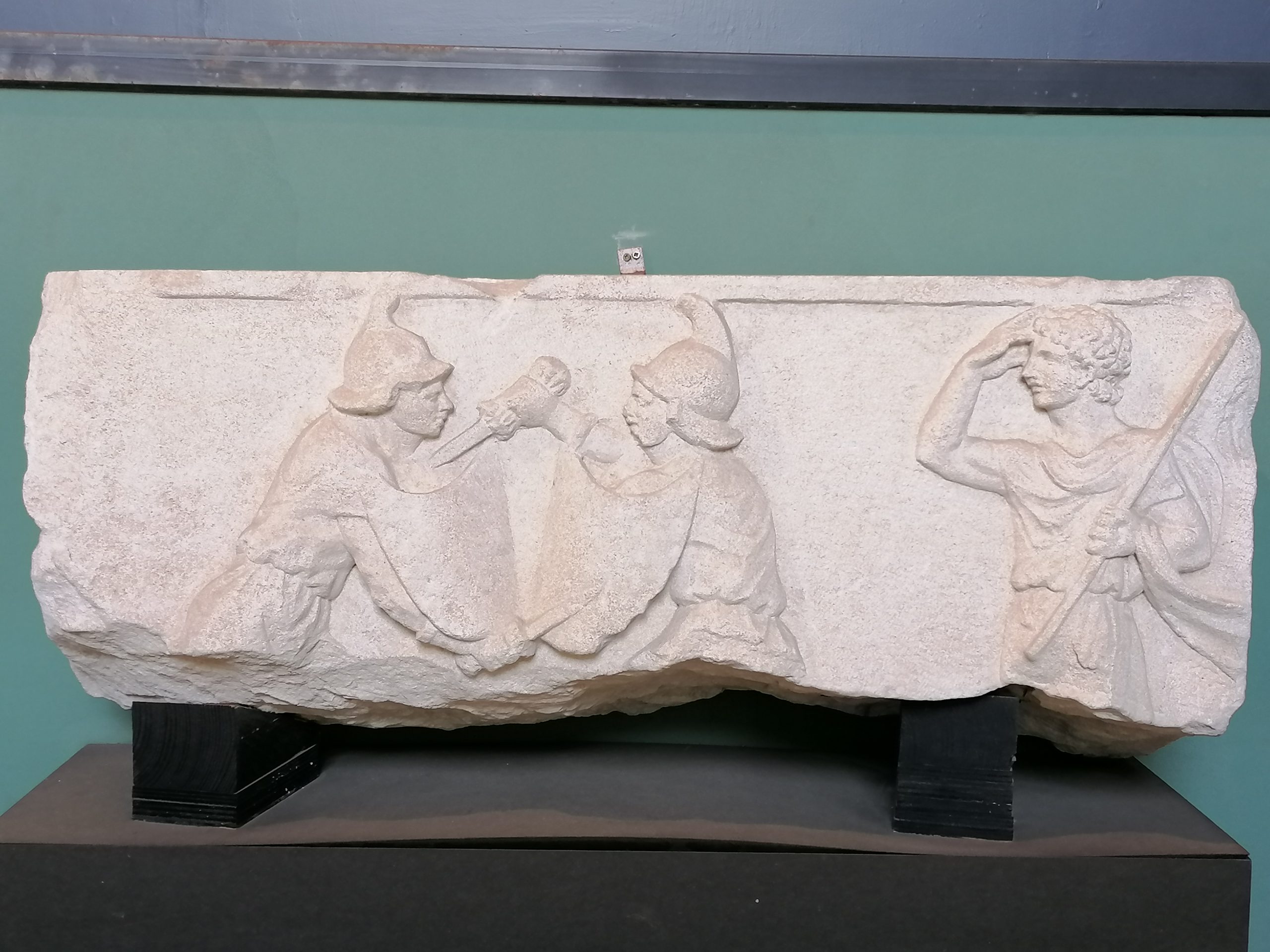
RILIEVO FUNERARIO CON GLADIATORI (fine del I secolo a.C.)
Funerary relief with gladiators belonging to a tomb from the ancient town of Nersae (Pescorecchiano, Rieti) depicting a fight between two gladiators. On the right, a referee (Summa rudis). -
The Gladiators' Couples
Gladiators were divided into various classes – we know 16 of them – and were categorized based on their origins, weapons, costumes, and fighting techniques.
These classes did not coexist together: in the early ages of gladiatorial combats, gladiators were impersonating the enemy to defeat, as the Samnes, the Gallus, and the Thraex.
The Samnes is the most ancient type of gladiator (Livy, 9, 40). The Gallus might appear during the Caesarian era, later changing his name at the end of the Republican period to Murmillo (Paulus ex Festo 359.1-5; Cicero, Philippicae, 3, 12). The Thraex, identifiable by the typically curved sword –sica– is often mentioned in Roman inscriptions from the 1st-2nd centuries A.D.
As said, the canon gladiatorial classification dates back to the Augustan era, and it was certainly completed by the time of the Flavian imperial dynasty, although further adaptions occurred. An inscription of a burial society in Rome, dated 177 A.D., during the reign of Commodus, lists names and descriptions of numerous types of gladiators based on their armors and categories: thraex, hoplomachus, essedarius, contraretiarius, murmillo, provocator, retiarius.
Based on the training level, an individual gladiator would be referred to as novicius, which meant just enlisted; tiro, a gladiator that had completed the training and wasready for his first fight; veteranus, when he had had at least one combat. At the end of every duel, the palma, a branch of palm, and the corona, a crown probably made of laurel, were given to the winner. The rudis, a wooden sword that acted as a trophy, was gifted to the gladiator at the end of his career.
In the 1st century A.D., a pardon – missio – was usually given to the exhausted gladiator when he gave a clear sign of surrendering by raising his left hand – the one for defense – high with the index finger up, a gesture described in the sources as “ad digitum pugnare”. Afterward, the sine missione fights would prevail, as the social prestige of the editor had to match his generosity.
The most common pairings of gladiatorial classes documented from the 1st century B.C. to the 4th century A.D. were: murmillo-thraex, murmillo-hoplomachus, retiarus-secutor. This exhibition is dedicated to them.
- Clay oil lamps with gladiators fighting. From permanent exibit “The Colosseum tells its history”, on the 2nd level of the Colosseum (Parco archeologico del Colosseo)
- Oil lamp with gladiator asking for mercy (missio). From the Kircherian Museum
-
Ambiente 2 - Mosaico con scena di caccia (venatio)
Mosaic with hunting scene (venatio) and inscription ex vicen(alibus) f(e)l(iciter) veli, related to the celebration of the twentieth year of the reign of the emperor Antoninus Pius (158 A.D.). The symbol of defeat, the THETA NIGRUM, refers to the death of the animal; the V, which can be read as vicit, to the victorious hunter; veli, which is difficult to integrate, is perhaps an abbreviation of the name of the hunter.
During the long days dedicated to spectacles in the amphitheatres, not only gladiator fights took place: hunting scenes or venationes were also very popular. This is the example of the mosaic on display. It depicts two figures with long hair and a short tunic facing a beast: for a long time, it was debated whether they were women or men. The current interpretation prefers to identify them as men. The presence of women in the arenas, as gladiators or hunters, is however attested by literary sources and archaeological documentation: often it was the emperors themselves who organised shows with women who, because of their rarity, enhanced the attractiveness of the performances.
From Rome, Castra Praetoria
2nd century AD
-
Ambiente 3 - Head of gladiator with helmet of the Gallus type
The limestone head found in the Verona arena shows a type of helmet that leaves the two eyeholes open, at a time that precedes eye protection with grids. Thisevolution is attested as early as the Augustan age with the reform of the gladiatorial classes, but it delays imposing itself for the helmet of the contrarete and the Gaul: in the case of the contrarete the eyeholes, which are small, were hardly reached by the trident of the reziario. In the case of the Gaulus fighting against his counterpart, the armor includes a long sword (spatha) that strikes by slash, not by tip, without touching the eye.
The possibility of recognizing a Gaul, explains the fact that the names of the oldest types of gladiators should be connected with the original geographical origin of the peoples who were enemies of Rome. This is the case of the Samnite (Samnes), the Thracian (Thraex), and precisely the Gaul(Gallus). During the imperial age the Gauls extended to other duels (against the Retiarius and Thraex), changing their ethnic armament and becoming Myrmillones.
Limestone
1st century A.D.
From Verona, Roman Amphitheater (Arena)
Verona, Archaeological Museum at the Roman Theatre
Inv. 29514
-
Room 4 - Murmillo and Thraex
SHOWCASE 1
THE MURMILLO GLADIATOR
As the secutor (seeker), the murmillo belongs to the scutarii, the category of gladiators using a big rectangular shield for defense. He wore a defensive armor characterized by a helmet with a brim folded on the sides for eye protection, made with a wide grid that gave them overall “good” vision. Their weaponry consisted of a gladius, an iron blade 40-50 cm long, completed with a short greave (ocrea) on the left leg and the sleeve (manica) on the right arm, stuffed with different linen or hard leather layers. The ocrea was secured to the calf by laces anchored to bronze eyelets. Despite the heavy and impenetrable armor, his classical opponent, the thraex, jumping over the shield and using his fearsome curved sword (sica), could tear the murmillo’s back at the hip or shoulder blade level.
THE THRAEX GLADIATOR
The thraex – named after his land of origin (Thrace) – is the highest representative of the parmularii category, the gladiators with small rectangular shields (parma). He is the usual opponent of murmillo. The thraex, wearing a helmet with a griffin-shaped crest (lophos), is easily recognizable by his peculiar weapon called “sica supina“, a sword originating in Eastern Europe in the shape of the beak of a flying griffin. The hook-shaped edge hit the back of the opponent, which was usually the murmillo. The shield was smaller than the scutarii’s ones: because of the shield’s small dimensions, the thraex had his thighs clad in high greaves (ocreae) up to the groin. The protection on exhibit – a reconstruction of the original bronze one found in the Barrack of Gladiators in Pompeii, now at the National Archaeological Museum of Naples – represented a valuable parade accessory. It is a very heavy bronze cast with highly elaborate decorations: the upper part depicts laurel and oak leaves and ears of wheat. In between the ocreae and the gladiator’s skin was a padded layer of protection.
SHOWCASE 2
PARADE HELMET OF MURMILLO
Helmet of murmillo in cast bronze: on the calotte are scenes with the personification of Goddess Roma Victorious as a bare breasted Amazon wearing a combat helmet.
She leans on a shaft with her left hand, holding the scepter with her right hand. She tramples on the enemies’ weapons, which are symbolically represented at her feet in a submissive pose. On the sides are other prisoners with their hands tied behind their backs. The decoration ends with two flying Victories looking at their enemy’s trophies, which are formed by shields, armor, and helmets typical of Northern Europe, with real or fake hair. The cheek-pieces are also plain and unadorned.
SHOWCASE 3
PARADE HELMET OF THRAEX
The bronze cast helmet on exhibit is characterized by a hemispherical calotte with a wide buffer brim that, unlike the other gladiators’ helmets, is more linear and has a slight folding close to the parietal bone. The complete face protection leaves only two holes for the eyes, covered by a grid: a particular design indicating the production during the Julio-Claudian age. A palm tree on the forehead represents the “palma lemniscata“, usually given to the fight winner. On the bronze visor are two little round shields (parmae) and two crossed spears, while on the top is the head of a griffin. Those symbols likely belong to an hoplomachus or a thraex gladiator (both parmularii, as they were armed with parmulae, which are smaller shields). On the sides of the helmet (galeae), there are two small openings for inserting plumes. Under the buffer brim are bronze reinforcements to protect against blows from the sides.
-
Room 5 - Secutor, Retiarius e Provocator
SHOWCASE 1

Seat from the Colosseum bleachers (cavea) bearing graffiti depicting a fight between a Secutor and a Retiarius. From the permanent exhibition “The Colosseum tells its history”, Colosseum, 2nd level. 2nd-3rd century A.D.
SHOWCASE 2
THE RETIARIUS GLADIATOR
The retiarius wore a wide loincloth (subligaculum), a belt (balteus), and a strong protection that was put on the left arm (manica) as it was the area most commonly hit by the secutor. The retiarius also wore the galerus, a metal plate on the left shoulder to protect his throat. He did not have a shield or a helmet, his only defensive weapon, besides the net (rete) and the trident (Festus, p. 358), was the dagger (pugio).
The retiarius is a new category of gladiator created at the beginning of the imperial age. The lack of the “typical” armor gives it more agility, mobility, and dexterity to compete against his opponent, the secutor, and his military-level power. The trident was his fearsome and effective weapon, with a decisive breakthrough as both hands held it. A well-struck blow must have resulted in significant trauma to his opponent, no matter the precision of the shot or the type of protection the secutor had.
The seeker or secutor (Isidore of Seville, Origines, 18, 55) is also known as the contraretiarius, as the retiarius was his only opponent.
His helmet was egg-shaped and smooth and was designed to avoid any grip on the grasp of the trident and the net of his enemy, the representative of the god Neptune. The weaponry of the secutor consisted of a short, straight, and not bulky sword, the gladius, a short greave (ocrea) on the left leg, and a padded sleeve (manica) to protect the hand. He was equipped with a large shield (scutum), of various types, sometimes with a semicircular top to protect him from the blow of his enemy’s trident. He defended his throat by wearing a metal or hardened leather polygonal guard, often with spikes.
A second homonymous contraretiarius, identified as cutter, or scissor, had the same secutor helmet but did not have a shield to protect himself from the trident’s power. Therefore, he utilized the typical double headed hammer and a sharp dagger. His defensive armor was scale cuirass (lorica squamata) that started below the groin, one of the sturdiest pieces of military uniform.
Complete armor of Retiarius gladiator on the left and Secutor gladiator on the right (Silvano Mattesini Collection). At the centre, marble relief from Island of Kos (Greece)
On display in the showcase is a relief with gladiatorial fight between the Retiarius Kritos and the Secutor Mariskos found on the island of Kos (Greece).
In the inscription two gladiators fight for victory, the retiarius with the typical trident on the left, and the secutor with the large shield and smooth helmet, on the right. Retiarius Kritos has been definitively released (apoluomai) ‘from the gladiators’ barracks’ (exo loudou), having thus obtained his definitive retirement from gladiature. This event can take the form of the release from the contract of the auctoramentum, the oath by which the auctorati, in exchange for money and for a limited time, agreed to sacrifice himself, fighting for the final redemption but risking death in the process.
2nd – 3rd century AD
Civico Museo d’Antichità “J.J. Winckelmann” (Trieste)
Next to the showcase 2:
WEISENAU HELMET
Military helmet of the Legio XXX Ulpia Victrix. Similar to the so-called Weisenau type, it was utilized by a provocator during the imperial age: it has a large neck guard and a solid front buffer. Replica of the original bronze helmet of Trajan age, now preserved in Bonn at the Rheinisches Landesmuseum.
MILITARY HELMET OF PROVOCATOR
Replica of a military helmet, utilised in war with the cheekguards in boiled leather: the typology is dated to the 2nd century B.C., with a front drop that seems to work well as a buffer.
- Military helmet of the Legio XXX Ulpia Victrix. Similar to the so-called Weisenau type, it was used by a Provocator during the imperial age: it has a large neck guard and a solid front buffer. Replica of the original bronze helmet of Trajan age, now in Bonn at the Rheinisches Landesmuseum (Silvano Mattesini Collection)
- Helmet of Provocator gladiator. The type is dated to the 2nd century BC (Silvano Mattesini Collection)
SHOWCASE 3
PROVOCATOR FROM THE IMPERIAL AGE
This gladiator type has a long story and a substantial evolution. It perfectly represented the fencing of equal and opposite forces, so much so that it is considered the “experimental” corp of the Roman legions. The equipment was typical of the scutarii with comprehensive defense and military-type gladius, utilized mainly at the blade tip. He wore a short greave (ocrea) on the left leg and chest protection (cardiophilax). The helmet was usually of the Gallic type, closed and without the crest, with frontal buffer and neck protection. The shield is rectangular.
- Complete armor of Provocator gladiator (Silvano Mattesini Collection)
- Complete armor of Provocator gladiator (Silvano Mattesini Collection)
-
Room 7 - The Hoplomachus or Thraex Type A
According to some scholars, the hoplomachus is part of the parmularii category and uses a round shield (parma) with a short, sharp dagger or machaera. In addition to the high greaves (ocreae) that reach the groin, he has extensive padded protections for the legs. The chest has no protection, as the attack was granted by his most offensive weapon, the spear. He wore a griffin-shaped helmet with a high brim adorned by plumes. The shield on exhibit is the replica of the original one from the Gladiators Barrack of Pompeii and originally on display at the National Archaeological Museum of Naples: it has a decoration with olive leaves coated in silver and copper. In the center is a Medusa’s head surrounded by the same naturalistic motives.
According to another interpretation, however, the hoplomachus is a scutatus (armed with a large shield) from the Samnite category. The gladiator with the small round shield would therefore still belong to the Thracian type.
- Complete armor of Hoplomachus gladiator (Silvano Mattesini Collection)
- CLAY OIL LAMP WITH FRIEZE OF WEAPONS Colosseum, permanent exhibition “The Colosseum tells its story”, 2nd level 1st century A.D. Parco archeologico del Colosseo
- Oil lamp with gladiator asking for mercy (missio). From the Kircherian Museum
-
Room 8 - Lifts and hoists for men and animals
In the underground level of the Colosseum there are at least two systems to lift men and animals for the performances in the arena.
The first system was built in the years of the inauguration of the Colosseum: it consisted of 28 hoists operated by as many winches, equipped with cages that could only hold smaller animals such as felines, wolves, boars, deer, antelopes. A total of 224 people were needed to operate the hoists simultaneously, 8 for each winch. The reconstructive models on display illustrate this specific system.
The second system, on the other hand, was installed during the 3rd century AD: on this occasion the number of hoists was increased to 60, now operated by a system of lead winches and counterweights of varying weights, and by ropes passing through pulleys inserted in travertine pillars, as the examples on display here illustrate.
-
The Gladiators' Glossary
GLOSSARY
Balteus: high belt | waist-band
Cavea: seats
Cardiophilax: chest protection
Corona: crew
Editor: shows organiser
Familia: group of gladiators belonging to a lanista
Equites: cavalry man
Galea: helmet
Galerus: metal protection of the retiarius’ left arm
Gladius: iron sword
Lanista: private entrepreneur
Libertus: free man
Lophos: crest
Machaera: sword
Manica: arm protection from shoulder to hand
Munus/munera: tribute, obligation, gift
Novicius: newly enlisted gladiator
Ocrea: leg protection
Opus spicatum: small brick floor arranged in a fishbone pattern
Palma: palm
Parma / parmula: small shield
Pugio: pugnale dagger
Rudis: wooden sword
Scutum: large rectangular shield
Subligaculum: wide thong
Summa rudis: referee
Sica: curved dagger
Summa rudis: referee
Tiro: a gladiator that has completed the training and is now ready for his first fight
Veteranus: gladiator who has fought at least one fight
-
Bibliography
Bibliography about Ludus Magnus
A.M. Colini, L. Cozza, Ludus Magnus, Roma 1962.
S. Serra, A. Ten, Ludus Magnus: dati per una nuova lettura, in Scienze dell’Antichità, 19.1., Roma 2013, pp. 203-218.
Bibliography about gladiators
A. Augenti, Spettacoli del Colosseo nelle cronache degli antichi, Roma 2001.
A. La Regina (a cura di), Sangue e arena, catalogo della mostra (Roma, 22 giugno 2001 – 7 gennaio 2001), Electa, Milano 2002.
M. Papini, Munera gladiatoria e venationes nel mondo delle immagini, Accademia nazionale dei Lincei, Roma 2004.
F. Guidi, Morte nell’arena. Storia e leggenda dei gladiatori, Mondadori, Milano 2009.
C. Mann, Gladiatori, Il Mulino, Bologna 2014.
S. Rinaldi Tufi, Gladiatori. Una giornata di spettacoli, Quasar, Roma 2018.
P. Arena, Gladiatori, carri e navi. Gli spettacoli nell’antica Roma, Carocci Editore, Roma 2020.
V. Sampaolo (a cura di), Gladiatori, catalogo della mostra (Napoli, Museo Archeologico Nazionale, 8 marzo 2021 – 30 giugno 2021), Electa, Milano 2020.
A. Russo, F. Rinaldi (a cura di). Iuri vinciri verberari ferroque necari. Studi e ricerche sul mondo dei gladiatori, Roma 2024.
Bibliography about relief from Island of Kos
L. Zenarolla, Rilievo con scena gladiatoria, in M. Verzár Bass (a cura di), Corpus Signorum Imperii Romani. Italia, Regio X – Friuli Venezia Giulia, Vol. II, Trieste 1, Raccolte dei Civici Musei di Storia ed Arte e rilievi del propileo, Roma 2003, pp. 120-125.


